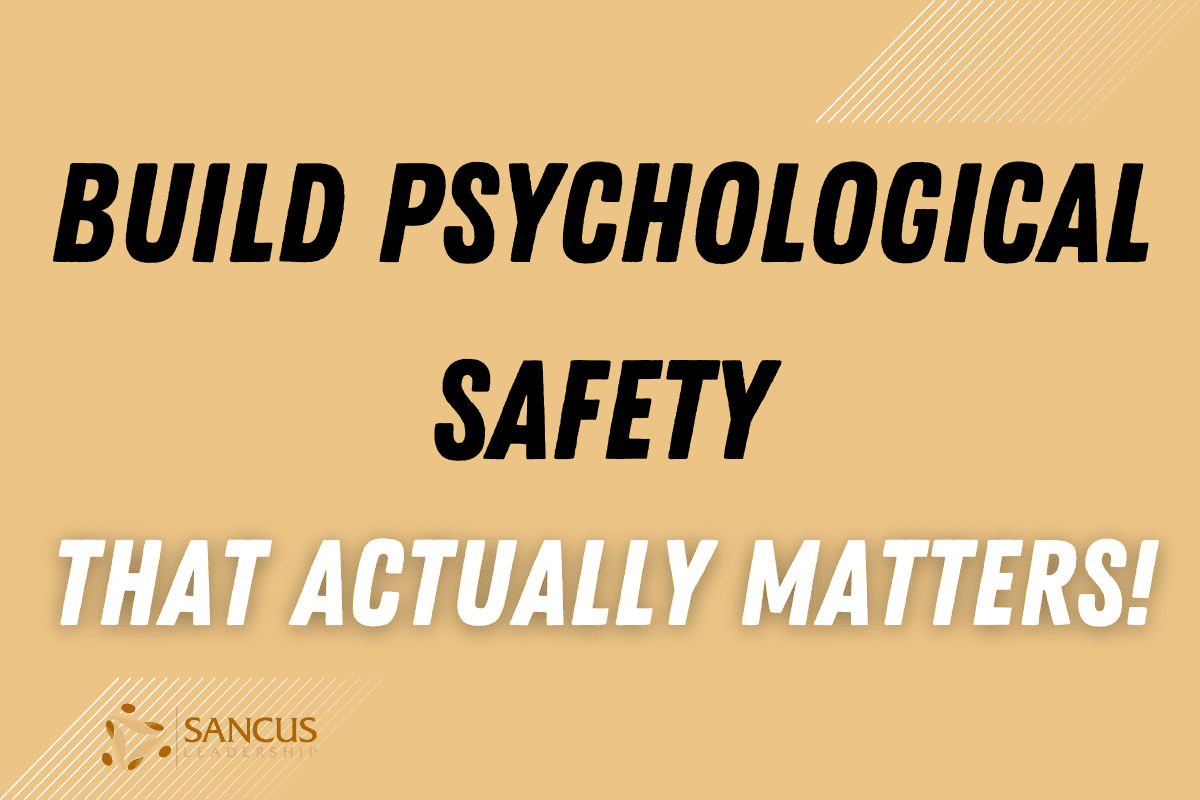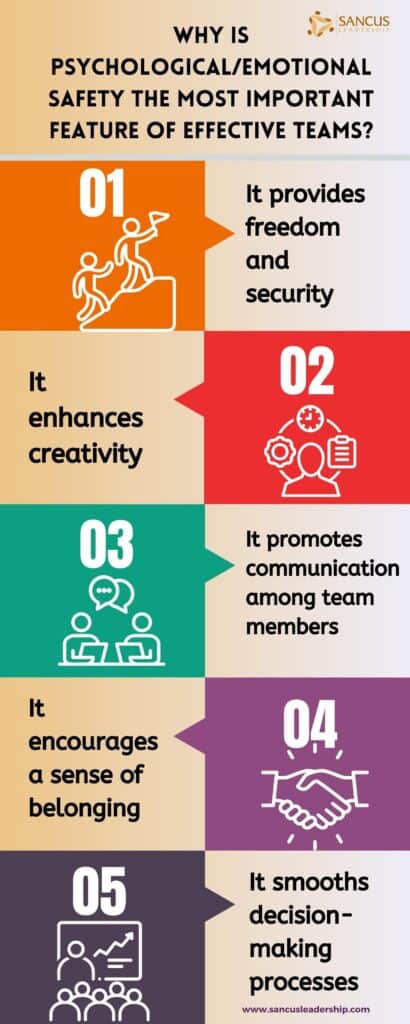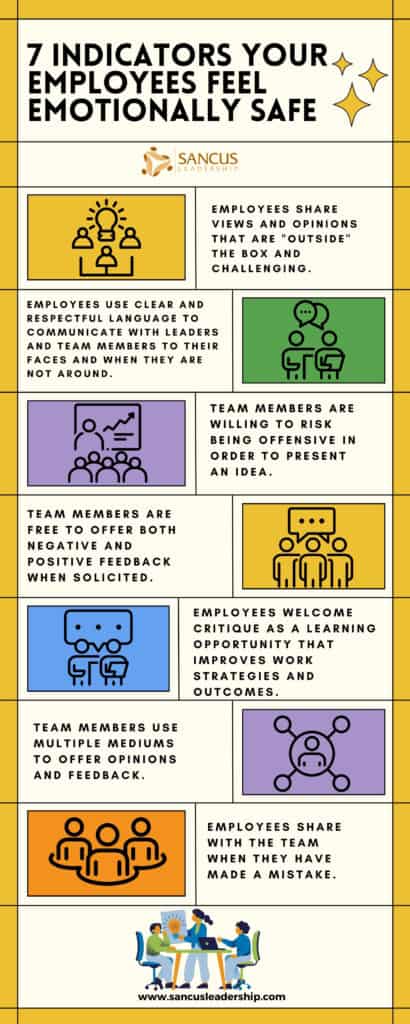Your cart is currently empty!

Build Psychological Safety That Actually Matters! (Army Perspective)
At Sancus Leadership, forging unbreakable trust has always been the main component when building long-term teams and developing talents. But it wasn’t until recently that we realized why this approach was so successful. Through the lens of performance, we can now clearly articulate why it is so important for team leaders to focus on psychological safety.
Building psychological/emotional safety on your team is the number one strategy managers can use to provide security to their employees and give them a reason to stay. It involves creating the right conditions so employees can express themselves freely without fearing being penalized.
Emotional and psychological safety originated in different contexts but are habitually used as synonyms when applied to the work context. I will use these terms similarly to discuss how we (and you?) promote emotional safety in the workplace and why doing so is important.
The Importance of Psychological/Emotional Safety for Teams?

It’s been said over the centuries that “two heads are better than one” when accomplishing work.
A recent study at the Wharton School of the University of Pennsylvania confirmed that teams are faster and more efficient than individuals when accomplishing complex tasks.
To be effective, teams in the workplace must meet certain characteristics. According to a Google study, psychological/emotional safety is the most important of the features of effective teams.
Here’s why.
- It provides freedom and security: Psychological safety gives employees the certainty that they will not be humiliated, sidelined, or punished when they share their ideas, challenge others’ ideas, or make mistakes.
- It enhances creativity: When employees feel safe to share their opinions, they are more likely to put forth ideas that develop new and more creative ways of achieving company goals.
- It promotes communication among team members: Freedom, trust, respect, confidence, and a sense of security are all qualities in a psychologically safe team. They are preconditions for open communication among team members.
- It encourages a sense of belonging: When employees can freely contribute, they build a sense of “our company/organization.” As a result, they are more engaged and happier with their work, and employee turnover is minimized.
- It smooths decision-making processes: Psychologically safe teams facilitate open and free brainstorming forums, allowing members to air their views openly. Teams can then weigh and evaluate these views and make faster and more viable decisions.

In a nutshell, emotional and psychological safety makes team members feel they are an active part of the process, which leads to achieving company goals. Therefore, managers should structurally build emotional/psychological safety in the workplace.
Managers should structurally build emotional/psychological safety in the workplace.
12 Steps to Promote Emotional Safety in the Workplace!

It’s essential for business managers and organizational leaders to bear in mind that psychologically and emotionally safe teams do not happen automatically. For this reason, managers and leaders have to work hand in hand with their employees to create teams where every employee feels psychologically/emotionally safe.
Promote emotional safety in the workplace by recognizing individuals, encouraging risk-taking, and “framing the work.” Managers should allow employees to make mistakes, value their opinions, and reward their input.
Here’s how you can use these and other strategies to create psychological/emotional safety on your team.
1. Be Intentional About Promoting Emotionally Safety
The Managers and leaders I have met who are consciously aware of the critical role of emotional safety in teams are likelier to promote it. They tend to build psychologically safe “cultures” through a structured approach instead of a more relaxed “hippie” way ;).
This appears to make employees feel protected and have greater reasons to stay in their job.
Being intentional about promoting an emotionally safe workplace culture involves the following.
- Being friendly with all your employees irrespective of their race, gender, qualifications, or rank (you don’t have to like them, but it is in your interest to respect them).
- Promoting free and open communication (even if you dislike what they say).
- Forging trust and respect among team members (learn how to forge unbreakable trust here).
- Being aware of employee life situations.
- Making awareness of emotional safety a part of induction and ongoing training initiatives.
2. Recognize Individualism
Every employee is a unique individual, and creating a team does not imply killing individualism. In fact, psychological/emotional safety supports the freedom to be oneself in a team.
Managers and organizational leaders need to create a work environment and managing style where every employee feels at home regardless of their personality, credentials, or rank. In short, managers and leaders must create an equitably safe work environment free of partiality or arbitrary employee discrimination.
Every time we hire someone new, we make sure to emphasize that “we hired you for who you are.” We didn’t hire them to replace someone or fill someone’s shoes. This allows the individual to bring out all their strengths and weaknesses instead of trying to fit in and play a role.
Every time we hire someone new, we make sure to emphasize that “we hired you for who you are“.
3. Encourage and Train Risk-Taking
“Mistakes are human” is one of the sayings we hear often. It simply means that it is normal to make mistakes.
Being able to make mistakes without the fear of being penalized is a core tenet of the concept of psychological safety. It is also key in creating emotionally safe teams characterized by interpersonal risk-taking.
The Google study about building the perfect team mentioned earlier in this article established that teams that made mistakes and took risks delivered better outcomes.
This discovery tells managers and leaders that employees will feel more secure in suggesting and trying new ideas if the work environment assures them it’s safe to make mistakes. Besides, we all know new ideas are at the heart of innovation and creativity in the workplace.
Coming from a military background in bomb disposal, something I often see lacking in a civilian team’s skillset is the ability to do a threat analysis quickly and effectively. Without this skill, individuals take either no risk at all or unnecessary and irresponsible risks.
Without this skill, individuals take either no risk at all or unnecessary and irresponsible risk.
Both ways present a problem for the team when trying to be high performing and reach its goals.
With only a short team discussion, you can clarify what risk tolerance is accepted and allow your team to work within those boundaries.
When you want to learn more about threat assessment for small teams so you can start innovating and bring in more money, I invite you to book a free call with me here.
4. Make Opinions Count
If there’s a context where people will prove true the saying “once bitten, twice shy,” it is when an opinion is turned down without being given a chance. No employee will want to air their opinions when they have been turned down repeatedly.
At my old command, we would regularly have “brainstorming” sessions aimed at solving everyday tasks; the commander would always start by saying, “There are no bad ideas,” but at the same time would also physically react in a sense that made us see he didn’t like what he heard.
This quickly turned into a very unproductive meeting where people eventually stopped saying anything other than what they knew would be appreciated by the commander. This meant that rarely was there a new and bold idea. Instead, it was all the same old with, at best, a new label.
The point here is that small team leadership is about actions more than words, and for your body to align with your speaking, you must truly believe in what you are saying. Otherwise, people will see you are faking it and call you out.
Fake it till you make it is your death sentence as a leader (pun intended ;)).
Fake it till you make it is your death sentence as a leader.
Unfortunately, my workplace was not the only one with this issue; employee opinions don’t seem to get a good hearing. According to Gallup, only 3 in 10 US employees feel strongly that their opinions at work count.
Employers can make their employees feel that their opinions are valued by doing the following.
- Promoting open dialogue during meetings and other formal or informal employee gatherings.
- Directly asking for feedback and ideas from employees.
- Endorsing good and feasible opinions, refining those that need improvement, and giving reasons why an idea is not adopted.
- Establishing feedback loops so employees can partake in decision-making processes.
5. Lead the Way
It might be easy to encourage employees to feel free and participate in teams. But when it comes to emotional safety, leading by example works better than words.
In her book, “The Fearless Organization” (available on Amazon.com), the pioneer of ‘team psychological safety’ Dr. Amy Edmondson, mentions three core leadership behaviors. She states that managing and leading teams can use these behaviors to support psychological safety in teams. Acknowledging your own fallibility is one of these behaviors, which indicates to employees that you do not feel pressured to be perfect all the time. This kind of honesty serves as an example to your employees.
You must show your employees that you feel safe to ask for help, put ideas on the table for scrutiny, ask questions, and admit uncertainty and mistakes. By doing so, you communicate to them that they can be and do the same.
6. Frame the Work
According to Dr. Amy Edmondson, framing work implies two crucial roles among managers and leaders.
- Consistently reminding employees of the importance of their work and the large numbers of people that rely on it.
- Retelling employees that the success of work is uncertain and that its success depends on each one of them.
Through these methods, managing and leading teams can indicate that the employee is a core determinant of work success. It also recognizes that the employee’s contribution is significant and a subtle invitation to do their best.
But once again, you must truly believe in this yourselves before you try to influence someone else. I guess Michael Jackson was right (that’s a reference to the song “Man in the Mirror” ;))
7. Recognize and Reward Employee Input
One of the most successful ways of making people feel emotionally safe at work is to thank them when they give opinions, suggest improvements, or point out mistakes.
Doing this strongly communicates that their employers appreciate their contribution, however minimal it might seem. In consequence, employees will bring their best selves to work.
Gratitude from leaders and managers also has a domino effect because it triggers a sense of worth and satisfaction. In fact, research has confirmed that gratitude enhances employee well-being, minimizes stress, boosts motivation, and strengthens resilience.
What I have found during my twelve years as a leader is that you want to be a scientist rather than a cheerleader; what do I mean by that?
A cheerleader screams “great job” or “let’s go” and makes you feel excited at the moment, but doesn’t do much for improved performance in the long run. and often, the value of “hurray” gets deflated and loses its value.
Scientists have a different approach; they identify exactly what leads to success and articulate that in a way that can be repeated.
I want your feedback to be like the scientist’s; make sure you are super specific about exactly what they did that you not only appreciated but also know contributed to the team’s success.
You will soon notice that your team feels valued and does more of the things you want, and wastes less time.
At Sancus Leadership we have learned a lot from the book Thinking Fast and Slow, it has changed how we give feedback, and allowed us to quickly build a culture where everyone knows what's important and what's not. When you want to do the same book a call with me here.
8. Work as a Scientist Testing a Hypothesis
If work is presented in a structure cut in stone that must necessarily lead to a specified outcome, then employees will feel like robot executors of the work.
Instead, work should be presented as a learning and testing experience where employees can be creative. That way, they won’t feel threatened if they make mistakes, and the output has better chances for greater quality.
Maybe it’s because I have always secretly wanted to be a scientist, but I keep coming back to the idea of seeing work as a way to test ideas.
A scientist never fails as long as the process is sound; the outcome is merely the response to the question that was asked. Sometimes it aligns with what we were hoping for; sometimes, the response is negative, but the lesson is always there.
Sometimes it aligns with what we were hoping for, sometimes the response is negative, but the lesson is always there.
So next time you try something new on your team, put on the white robe and run the experiment, get the lesson, and improve the process. It’s as simple as that.
Redefine what failing and winning mean on your team!
9. Use Constructive and Influential Language
When communicating with your employees, the choice of words can strengthen or weaken their willingness to be themselves. For example, instead of saying a newcomer employee cannot take up a task, you should consider saying the employee has not performed the task yet.
Putting it that way will give the employee the impression that you believe in their capacity to perform the task once they are acquainted with the new work environment. As a result, hopefully, the employee will be bold in sharing or challenging ideas around the task.
Doing that can help them prove they can accomplish the task despite being new to the place; it puts them in a position where they can become a winner.
10. The Biggest Unknown Mistake
When I attended officer training school, I was fortunate enough to get to know a candidate called Hank. Hank was a very peculiar person; he had many interesting (most of my colleagues used the word “weird”) perspectives.
Hank was ten years older than me (he still is, I guess ;)), an Afghanistan war veteran with many years of experience with life in the army. He told me a few words which I have tried to honor throughout my career.
Never ever give your subordinates an impossible task!
Never ever give your subordinates an impossible task!
So what is the impossible task?
There are three reasons why a task can be deemed impossible, the competency of the individual, the complexity of the task, or the complexity of the situation.
Your role as a leader is to NEVER give your people a task they will most definitely fail trying to accomplish. This will leave them feeling incompetent and like a failure, even though it is actually your fault as the leader.
I actually made this exact mistake yesterday; I delegated a task to my virtual assistant without giving her enough training and information to succeed. I gave her an impossible task!
I own this mistake, and I´m now working on a new SOP (standard operating procedure) that will be much more specific and in detail so she is able to succeed.
When your people fail to miss the mark, I challenge you to ask yourself the question; Did I delegate the impossible task?
11. Show Concern for Employees as Persons
It’s not rare to find managers who consider their employees solely as tools who put their professional expertise into accomplishing company goals.
Actually, this is exactly what my old commander told me when he introduced himself to the company, “Gabriel, I don’t care about you as a person. I care about you as a function of the armed forces.”
Well, at least he was honest…
After those words, everything he said felt fake and manipulative; there was no genuine care for us as human beings. In the corridors, employees started questioning the motives behind his decisions, and one of the golden rules of leadership was broken. Trust.
I truly encourage you to learn why trust is the core premise of every effective team by reading this article.
Nonetheless, more and more managers have realized that appreciating employees in their entire human experience enhances their motivation and engagement at work.
An employee with a boss who enquires about their well-being or family (because they truly care) will feel that they are appreciated for who they are holistically, not just as workers. As a result, they will be free to express themselves at work without the fear of being judged for who they are beyond their work.
12. Promote Employee Self-Awareness
Self-awareness describes a person’s ability to focus on their feelings and thoughts and determine their alignment with reality. People adept in self-awareness are more conscious of themselves and fit better in teams.
When employees are self-aware, they can establish if their thoughts and feelings impact their contribution to teams negatively or positively. For example, a self-aware employee is more conscious about their emotional responses to challenges. Such an employee is less likely to respond to a challenge on their idea with an angry outburst.
Managers can help employees become more self-aware by encouraging the use of simple tools such as journaling. They can also utilize more complex self-awareness tools like the Emergenetics Profile.
As a suggestion, the above strategies for promoting psychological/emotional safety on workplace teams may require creative adapting. Customizing these strategies will help fit them into the specific working context of your company or organization.
| Steps | Description |
| 1. Be Intentional About Promoting Emotionally Safety | Be intentional about promoting emotional safety by building a psychologically safe “culture” through a structured approach, promoting free and open communication, forging trust and respect among team members, being aware of employee life situations, and making awareness of emotional safety a part of induction and ongoing training initiatives. |
| 2. Recognize Individualism | Recognize individualism by creating a work environment and managing style where every employee feels at home regardless of their personality, credentials, or rank. |
| 3. Encourage and Train Risk-Taking | Encourage and train risk-taking by promoting an environment where mistakes can be made without the fear of being penalized. |
| 4. Make Opinions Count | Make opinions count by listening to and valuing employees’ opinions, suggestions, and feedback. |
| 5. Lead the Way | Lead by example and demonstrate vulnerability by showing employees that it is safe to ask for help, put ideas on the table for scrutiny, ask questions, and admit uncertainty and mistakes. |
| 6. Frame the Work | Recognize and reward employee input by thanking employees when they give opinions, suggest improvements, or point out mistakes. |
| 7. Recognize and Reward Employee Input | Present work as a learning and testing experience where employees can be creative instead of a rigid structure that must lead to a specified outcome. |
| 8. Work as a Scientist Testing a Hypothesis | Use constructive and influential language by choosing words that strengthen employees’ willingness to be themselves. |
| 9. Use Constructive and Influential Language | Avoid giving tasks that employees will most definitely fail at, which can leave them feeling incompetent and like failure. |
| 10. The Biggest Unknown Mistake | Show concern for employees as persons by considering their well-being and family, not just as workers. |
| 11. Show Concern for Employees as Persons | Promote employee self-awareness by encouraging the use of simple tools such as journaling and more complex self-awareness tools. |
| 12. Promote Employee Self-Awareness | Forge unbreakable trust among team members by building connections and being transparent about goals, values, and expectations. |
How To Know if Your Employees Feel Emotionally Safe

Once managers and leaders have made an effort to promote emotional/psychological safety on their teams, they should also observe the team’s physical and verbal reactions in order to understand if employees feel psychologically safe.
Here are some indicators your employees feel emotionally safe in working teams:
- Employees share views and opinions that are “outside” the box and challenging.
- Employees use clear and respectful language to communicate with leaders and team members to their faces and when they are not around.
- Team members are willing to risk being offensive in order to present an idea.
- Team members are free to offer both negative and positive feedback when solicited.
- Employees welcome critique as a learning opportunity that improves work strategies and outcomes.
- Team members use multiple mediums to offer opinions and feedback.
- Employees share with the team when they have made a mistake.
Overall, emotionally safe employees are more motivated and engaged because they identify with team and company goals and invest part of themselves in realizing them.

Final Thoughts
Building psychological/emotional safety on teams is a commitment that managers and leaders seeking success in the companies must embrace.
Building emotional safety involves appreciating employees as individual team members with the capacity to contribute ideas and opinions and the right to be heard without prejudice.
If your employees are happy and free to share ideas and are not afraid to make mistakes or challenge others’ ideas, you’ve successfully built an emotionally safe team.
